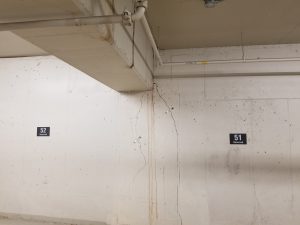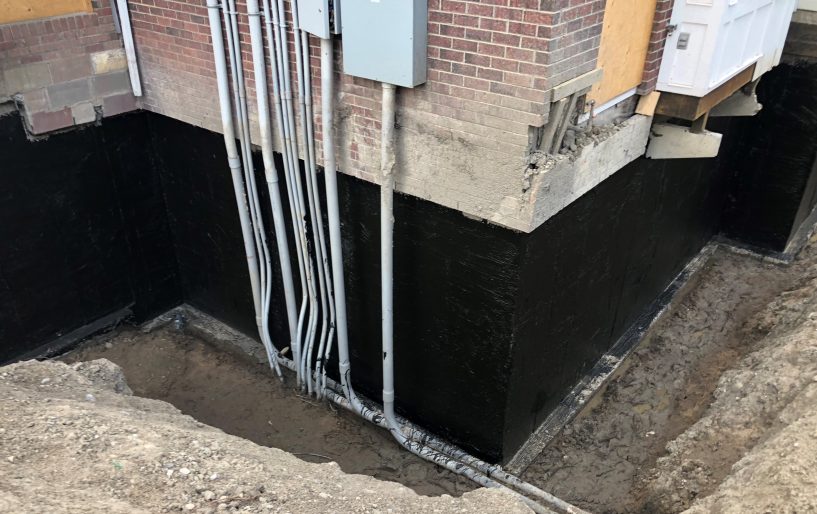Basement leaks are a common issue in older, smaller residential buildings. Annoying and potentially costly for owners, they aren’t necessarily a sign that the building was poorly constructed.
“Time works against older buildings,” explains Violet Lim, Project Engineer with RJC Engineers. “However, new builds are also susceptible to leaks. Concrete foundation walls can be just as vulnerable as those made of masonry or concrete block units.”
In most cases, Lim says leaks are a result of an unfortunate combination of time and forces of nature. Concrete inevitably cracks at some point in time, and often these cracks will extend the width of a basement’s foundation wall (known as “through-cracks”), allowing water in saturated soil to seep through.
According to Lim, basement leaks are typically caused by one, or a combination, of the following:
- Hydrostatic pressure
This occurs when the soil below the foundation and/or around the foundation walls is saturated with water, creating pressure against the foundation slab from below or against the walls. If the walls are not adequately waterproofed, or if there are through-cracks present and the water isn’t properly drained away from the foundation wall via a weeping tile system at the foundation’s footing, water is forced into the basement.
“Some soils, like sand or loam, absorb little water and allow fast drainage, while clayey soils are very absorptive and potentially expansive when saturated,” says Lim. “If water is not adequately discharged via weeping tiles to a municipal storm drainage system, surface soil can become saturated during heavy rain or snowmelt events.”
Additionally, blocked or clogged gutters and downspouts that do not extend away from the building will discharge large volumes of water adjacent to the foundation.
- Seepage
If the top of a foundation wall is below the surface soil grade, seepage is likely to occur over the top of the wall during heavy rain or snowmelt events.
- Backsloping
Sometimes a negative-sloped yard that slopes towards the building rather than away from it, will direct large volumes of water to the exterior wall and create hydrostatic pressure. “If that wall is not adequately waterproofed, and if cracks are present, the water will have nowhere else to drain,” warns Lim. “If there is no weeping tile system at the foundation footing to direct water to a storm sewer system, then leaking will occur into your basement.”
- Poor reinforcement
A foundation wall that has too little steel reinforcement sometimes results in structural cracks that extend the width of the wall, allowing water to seep through. Bowing foundation walls and/or horizontal cracks at or near the mid-span of the basement wall are indicative of inadequate steel reinforcement within the walls.
“However, the most common source of water seepage is actually through non-structural cracks in a concrete wall,” Lim says. “Both structural and non-structural cracks are caused by different mechanisms and require different repairs or combinations of repairs.”
- Clogged window wells
While most window wells come with drains in case water accumulates from heavy rain or snowmelt events, these drains may become clogged or may be missing entirely, in which case water will enter around the window.
 Preventative maintenance and repair tips
Preventative maintenance and repair tips
Typically, basement repair leaks can be performed from the inside or the outside as needed, and they can be done on concrete, cement block, or masonry foundations. According to Lim, there are several ways to repair existing leaks and prevent future ones from occurring.
- Install a waterproofing membrane on the exterior side of the foundation wall. This would require excavation of soil to facilitate the installation. At the same time, if not already installed, Lim recommends adding an exterior weeping tile or drain system. This is a belt-and-suspenders system designed to reduce hydrostatic pressure during heavy rain or snowmelt events, and to direct large volumes of water away from the foundation wall to the storm sewer system
- If the grade is backsloped towards the house, it should be properly re-sloped away from the building.
- If there are structural cracks present in the concrete wall, this could be a sign that the structure is shifting or sinking, or that there is inadequate steel reinforcement within the wall. Consult a structural engineer, as structural repairs may be required. If the engineer deems that the cause is inadequate steel reinforcement within the wall, the wall then needs to be stabilized, usually in the form of supplementary steel reinforcement installed in the basement interior. Both structural and non-structural cracks can be sealed from the interior via expanding polyurethane crack injections, which is an expanding, flexible material that fills and seals the crack. If the cracks are narrow enough, they can be bridged with an exterior waterproofing membrane.
- Window wells that don’t have drains should have them installed to direct water to the weeping tile system below or away from the building. Clogged drains should be inspected regularly and cleaned of debris. Window well covers keep out debris and minimize the chances of a drain from being clogged.
Implications of unchecked water leakage
Water is the source of most building issues, and these can exacerbate or compound over time. For buildings that have gypsum board drywall covering interior basement foundation walls, the presence of water promotes the growth of mould, which is dangerous and harmful to your occupants’ health. Additionally, leaks can cause further structural damage if not dealt with in a timely fashion, potentially rendering the foundation and the building unsafe. As such, Lim says it is crucial to detect any moisture ingress as early as possible.
For more information on preventing basement leaks, please visit www.rjc.ca or contact Violet Lim directly at vlim@rjc.ca







